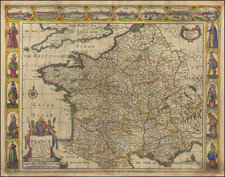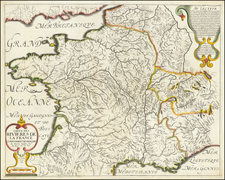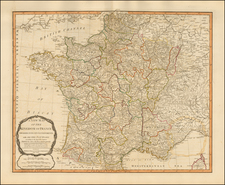Scarce early postal map of France, published in Nuremberg. The map includes an elaborate cartouche with coat of arms.
The map shows the early postal routes which criss-cross the country. Detail is extensive, with many regions named and towns and cities shown. Relief is indicated pictorially.
The French Post
In 1477, Louis XI set up a Royal Postal Service, employing 230 mounted couriers, which was not intended for public use. The security and regularity of the service along certain routes, when compared to previous means of communication, inevitably resulted in an increasing amount of unofficial correspondence being carried. After initial attempts to prevent this practice, its fiscal advantages were realized, and private mailings were legalized in the early 17th Century. The basis of a real public service was not created until 1627, when fees and timetables were fixed and post offices established in the larger cities.
In 1672, France made postal services a controlled state monopoly. Previously granted private operators were allowed to continue, but over time they were forced out of business or acquired by the state. In 1719 the University of Paris, the most important private competitor, gave up its last postal privileges in return for substantial compensation.
Homann Heirs was a German publishing firm that enjoyed a major place in the European map market throughout the eighteenth century. Founded in 1702 by Johann Baptist Homann, the business passed to his son, Christoph, upon Johann’s death in 1724. Christoph died in 1730, aged only 27, and the firm was inherited by subsequent Homann heirs. This altered the name of the company, which was known as Homann Erben, or Homann heirs. The firm continued in business until 1848.










![[France, Low Countries & Western Germany] Tab. III Europae, Galliam, Belgicam, ac Germaniae, partem . . . .](https://storage.googleapis.com/raremaps/img/small/75570.jpg)


![[Ptolemy's France] Europ III Tab](https://storage.googleapis.com/raremaps/img/small/89187.jpg)
